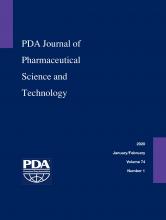Research ArticleResearch
Development and Validation of a HPLC-UV Method for Urea and Related Impurities
Getachew Woldemariam, Ali Kyad, Stephanie Moore, Jinshu Qiu, David Semin, Zhixin J. Tan and Jette Wypych
PDA Journal of Pharmaceutical Science and Technology January 2020, 74 (1) 2-14; DOI: https://doi.org/10.5731/pdajpst.2018.009803
Getachew Woldemariam
Attribute Sciences, Amgen, Inc. Thousand Oaks, CA
Ali Kyad
Attribute Sciences, Amgen, Inc. Thousand Oaks, CA
Stephanie Moore
Attribute Sciences, Amgen, Inc. Thousand Oaks, CA
Jinshu Qiu
Attribute Sciences, Amgen, Inc. Thousand Oaks, CA
David Semin
Attribute Sciences, Amgen, Inc. Thousand Oaks, CA
Zhixin J. Tan
Attribute Sciences, Amgen, Inc. Thousand Oaks, CA
Jette Wypych
Attribute Sciences, Amgen, Inc. Thousand Oaks, CA

References
- 1.↵
- Breslow R.,
- Guo T.
- 2.↵
- Marston F. A.
- 3.↵
- Setlow J. K.
- Kelley R. F.,
- Winkler M. E.
- 4.↵
- Yamaguchi H.,
- Miyazaki M.
- 5.↵
- Clark E. D. B.
- 6.↵
- 7.↵
- 8.↵
- Zhang J.,
- Siva S.,
- Caple R.,
- Ghose S.,
- Gronke R.
- 9.↵
- Choe W.,
- Durgannavar T. A.,
- Chung S. J.
- 10.↵
- Pathak M.,
- Ma G.,
- Bracewell D. G.,
- Rathore A. S.
- 11.↵
- Schiel J. E.,
- Davis D. L.,
- Borisov O. V.
- Prakash K.,
- Chen W.
- 12.↵
- 13.↵U.S. Pharmacopeial Convention. USP Monograph: Urea. In USP 42-NF 37, USP: Rockville, Md., 2019; p 4515.
- 14.↵
- 15.↵
- 16.↵
- Pibarot P.,
- Pilard S.
- 17.↵
- Rahmatullah M.,
- Boyde T. R. C.
- 18.↵
- 19.↵
- Wheatley V. R.
- 20.↵
- 21.↵
- Yassine M. M.,
- Dabek-Zlotorzynska E.,
- Celo V.
- 22.↵International Conference for Harmonisation. Quality Guideline Q2(R1): Validation of Analytical Procedures: Text and Methodology; ICH: Geneva, 1995.
In This Issue
PDA Journal of Pharmaceutical Science and Technology
Vol. 74, Issue 1
January/February 2020
Development and Validation of a HPLC-UV Method for Urea and Related Impurities
Getachew Woldemariam, Ali Kyad, Stephanie Moore, Jinshu Qiu, David Semin, Zhixin J. Tan, Jette Wypych
PDA Journal of Pharmaceutical Science and Technology Jan 2020, 74 (1) 2-14; DOI: 10.5731/pdajpst.2018.009803
Jump to section
Related Articles
- No related articles found.
Cited By...
- No citing articles found.





